|
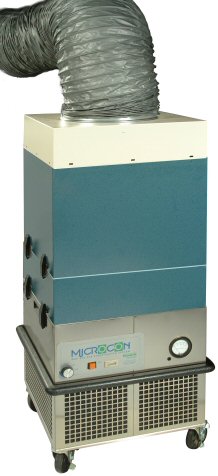
MICROCON® 800
- Survivor Series
The purpose of the MICROCON® SS is to provide
a rapid, simple and economical means of providing high
volume highly filtered and irradiated safe breathable
air to a secured contained space. The shelter will maintain
a slight positive pressure by the air being admitted.
It's portable and can be wheeled to a predetermined location
or permanently mounted and installed. The two pre-requisites
for installation are an air source and 115V power.
Outside air (or any
air source) is drawn into the unit through a 10-12" duct
that attaches to the duct collar mounted to the intake
of the HEPA filter cube. After numerous stages of filtration
any incoming air has been thoroughly cleansed, irradiated
and rendered safe of any airborne pollutants or contaminants.
1st Stage
- particulate pre-filtration:
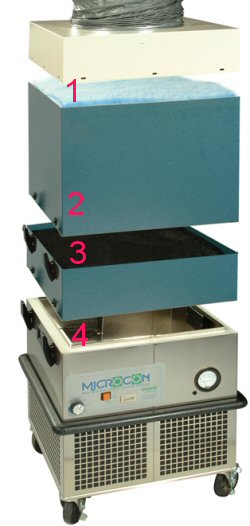 Incoming
air is first filtered through a 100% polyester
fiber, 3-stage panel filter. The polyester filter
will not absorb moisture or shed. The composition
of the matrix is a dry open web that serves a first
stage pre-filter for entrapment of larger size
particles. The second stage is comprised of finer
denier fibers to entrap smaller particles. The
final layer is a tightly needled matrix treated
with a non migrating tackifier for even smaller
size particles. The progressive filtration feature
of graduated densities allows for the finer size
particulate to become entrapped deep within the
filter thereby increasing filter life and efficiency.
This first stage filter is to provide the larger
size particles from reaching the HEPA filter thereby
increasing its life and efficiency. Incoming
air is first filtered through a 100% polyester
fiber, 3-stage panel filter. The polyester filter
will not absorb moisture or shed. The composition
of the matrix is a dry open web that serves a first
stage pre-filter for entrapment of larger size
particles. The second stage is comprised of finer
denier fibers to entrap smaller particles. The
final layer is a tightly needled matrix treated
with a non migrating tackifier for even smaller
size particles. The progressive filtration feature
of graduated densities allows for the finer size
particulate to become entrapped deep within the
filter thereby increasing filter life and efficiency.
This first stage filter is to provide the larger
size particles from reaching the HEPA filter thereby
increasing its life and efficiency.
2nd Stage
- high efficiency particulate filtration:
The high capacity HEPA filter is manufactured
with a high alpha high capacity micro-glass media. Filters
are 99.99% efficient and tested individually and certified
to have a maximum efficiency of not less than 99.97%
when challenged with .3 micron size particles of a thermally
generated challenge agent. The HEPA filter is permanently
sealed and encapsulated within a steel enclosure that
guarantees a self-aligning leak free seal. HEPA filters
are the only filtration device that has the capacity
to contain nuclear particles. True bag-out filter replacement
eliminates any exposure to the contaminated filter by
maintenance personnel during filter renewal procedures.
3rd Stage
- odor/fume adsorption:
Once the particulate matter is eliminated from
the air stream by the progressive filtration stages,
the gas air pollutants are then addressed by a series
of activated carbon cells. These contain 60% activated
premium grade coconut shell carbon granules for absorption
of odors and gases from the air-stream. There is also
the addition of impregnated carbons and potassium permanganate
for removal of compounds such as ammonia, hydrogen sulfide
and formaldehyde which carbon has little effect on.
4th Stage
- germicidal irradiation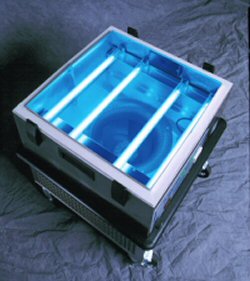 : :
The base of the fan module contains four 16",
254nm germicidal ultraviolet (ultra violet)
lamps. The 254nm wavelength had been recognized as
an effective means
of air disinfection. The UV works by breaking down
and altering the DNA molecules which consequently destroys
replication and kills the cell. Where HEPA filters
have
proven to be effective in containment of microbial
contamination such as bacteria, mold spores, mildew,
dust particles
and pollen, UV works on smaller size organisms that
would not be contained by the HEPA filter. These would
include
organisms in the various virus families. The lamps
are purposely positioned downstream of the HEPA filters
to
protect the lamps surfaces. Since all particulate matter
has been eliminated by the air stream there are no
airborne particles to attach themselves to the lamp
surface thereby
reducing their irradiation levels. It also eliminates
the need for periodic cleaning of the lamp surfaces
which is a customary and required procedure when utilizing
UV lamps. Lamps are designed for approximately 6000
hrs.
of operation before they require renewal.
The unit is modular in design and each stage is an individual cell that locks
and seals to the proceeding module. The
base is designed to exhaust air in a 360° direction.
This disperses air in all directions and eliminates positioning concerns.
In the event a single exhaust duct is required, we simply use block-out
panels to block exhaust in all but one direction. This could be of any
of the four sides. locks
and seals to the proceeding module. The
base is designed to exhaust air in a 360° direction.
This disperses air in all directions and eliminates positioning concerns.
In the event a single exhaust duct is required, we simply use block-out
panels to block exhaust in all but one direction. This could be of any
of the four sides.
A
variable speed electronic fan control knob adjusts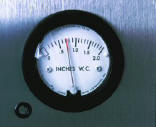 the
cfm volume. An electronic hour meter monitors the overall
operation time of the system. A pressure differential
gauge is incorporated to constantly monitor the pressure
differential in the system thereby identifying when
filters require replacement. the
cfm volume. An electronic hour meter monitors the overall
operation time of the system. A pressure differential
gauge is incorporated to constantly monitor the pressure
differential in the system thereby identifying when
filters require replacement.
The
fan is permanently sealed and self lubricated and requires
no maintenance or adjustment.
The
base is of stainless steel construction with four,
four inch rubber wheels (two locking). The exterior
surfaces of the filters are powder coated baked on
steel.
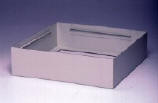 If
permanent installation is required, a pedestal can
be included to fasten to the floor, preventing mobility. If
permanent installation is required, a pedestal can
be included to fasten to the floor, preventing mobility.
Sizing:
Adequate air flow in a shelter calculates to about
4 cubic feet per minute (cfm) per person (or 6.6 meters
cubed per hour (m3/h)). In a humid environment these
figures should be increased by a factor of 2. Based upon
a conservative air delivery of 600 cfm, there is 36,000
cfm of filtered air being delivered each hour.
The integrity of
the shelter itself is critical to survival success.
An air tight shelter is paramount with a slight positive
pressurization to the surrounding areas. An exhaust
system is required to rid the shelter of pollutants
and gases generated within the space.
Other system considerations:
The MICROCON® is the only component in a system that
must include various other components and systems to
accomplish a total secure environment. For example, a
power source must be available to provide power and run
the various appliances needed. This might include a gas
powered generator and supply of fuel. Food type and storage
must be addressed. Communication equipment to allow contact
and information with the outside. Some means to condition
(heat or cooling) the inside air. Heat and humidity will
increase very rapidly inside a sealed shelter area. A
means for the elimination of waste material. A system
for storage and replenishment for the water supply, and
light sources, both battery and generator types.
The design of the
shelter should depend upon the anticipated longevity
of occupation, the number of occupants, and to what
degree of inclusion the systems must be incorporated.
Several factors will ultimately determine the success
rate of the shelter such as the severity of an incident,
weather conditions, and proximity to ground zero. Being
prepared will only improve the survival rate for those
who plan ahead.
|

